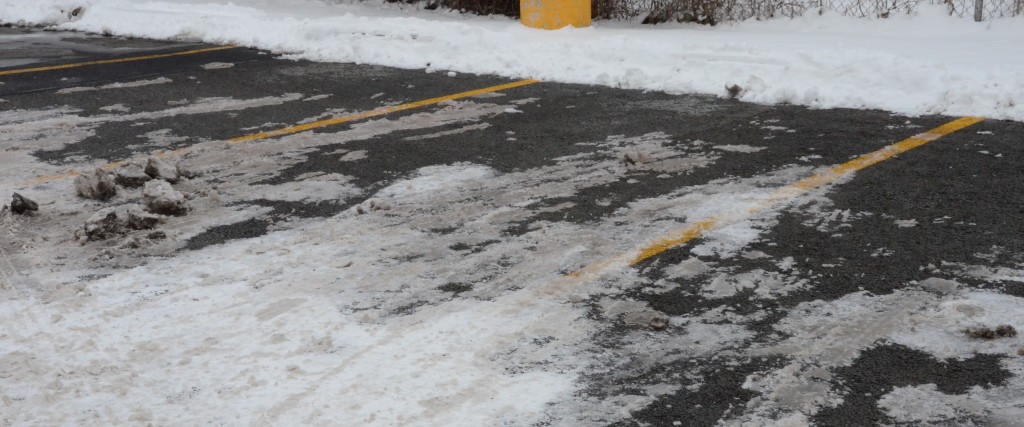
Porous pavement allows water to absorb into portions of the parking lot at the Petit Branch Library. (Heather Norris)
To get cleaner water around Syracuse, one of the newest solutions is porous street pavement, say government officials and environmental experts.
“You have an influx of water that goes into the stone and over time it would perk back into the soil,” said Gordon Hyatt, vice president of Klepper, Hahn & Hyatt structural engineering and landscape architecture company. It is one of the engineering companies working with the Save the Rain campaign for Onondaga County.
Save the Rain is a county-run program aimed at curtailing polluted sewer overflows that have contributed to the pollution of Onondaga Lake and other local waterways. The program is a result of a 1998 court ruling requiring the county to reduce contamination of the lake by untreated sewer overflow. The Save the Rain campaign started in the city in 2009. As part of the campaign, the city has experimented with green roofs, rain gardens and porous pavement.
In 2012, the county expanded the program into the suburbs and allocated $3 million for suburban improvements. This year, the county’s proposed budget calls for $2 million towards suburban efforts.
The Save the Rain website lists 44 porous pavement projects across the county designed to help rain water drain into the soil instead of flowing into the sewer system. Rain water in sewers poses the risk it can overflow into waterways after mixing with other sewage. Those projects include:
- Syracuse Creekwalk , between Jefferson and Walton streets, at at cost of $63,311 to capture 135,000 gallons per year.
- Connective Corridor along University Avenue, at a cost of $948,717 to capture close to 5.7 million gallons per year
- Town Hall of Geddes parking lot, at a cost of $119,000 to capture nearly 1.4 million gallons per year
- Petit Library parking lot, located off of Victoria Place in Syracuse, at a cost of $132,146 to capture 254,000 gallons per year
- OnCenter surface parking lot, at a cost of $529,040 to capture nearly 2.4 million gallons per year
The city’s sewer system is a challenge for the county, said Madison Quinn, public information specialist for the Onondaga County Save the Rain program. The city’s sewer system is combined, said Quinn, so industrial waste, household waste and storm water all flow into the same underground channels. Excessive storm water going into the system causes overflow.
“If there was no overflow, it would either come back up or it would bust your pipes,” she said. Quinn added, “Basically, the goal of Save the Rain is to keep the water from overflowing as often as possible.”
The porous pavement, said Hyatt of the environmental engineering company, works like this: Regular pavement is rolled tightly underneath the surface of the roadway, with a density of about 95 percent. But porous pavement includes open stone underneath the surface of the road through which water can travel. This looser stone, Hyatt said, contains open spaces where water can pass through.
That means the water will soak into the pavement and eventually filter into the soil below instead of traveling on top of the denser pavement of roads, parking lots, sidewalks and gutters to inevitably flow into the sewers.
Douglas Daley, an environmental engineering professor at SUNY ESF, praises the way porous pavement works. “The pavement itself isn’t really intended to provide treatment,” he said. But it is designed to return the water to the soil, where it would be naturally if the roadway was not there.
Said Daley: “It’s pretty impressive, actually.”
(Heather Norris is a graduate journalism student at Syracuse University)
-30-


